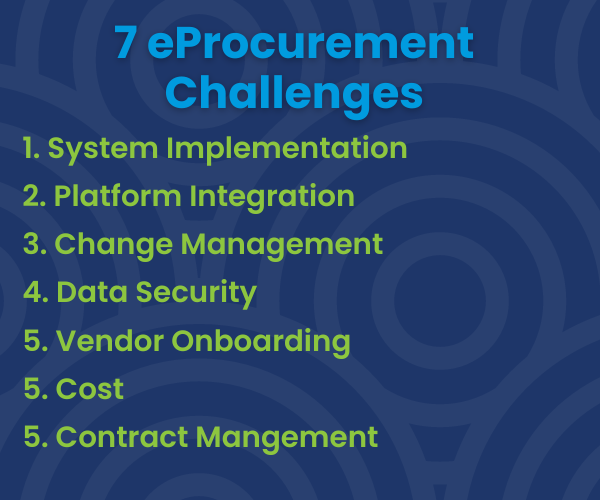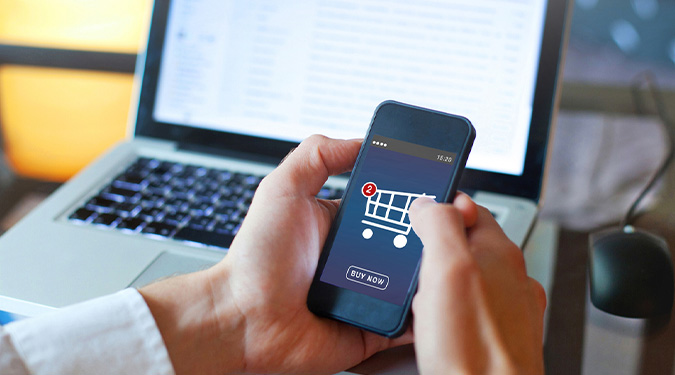Table of Contents
eProcurement platforms help organizations improve their procurement processes, reduce costs, and mitigate risks. They provide a centralized place for managing procurement activities and can help companies achieve greater efficiency and transparency in their purchasing operations.
Adopting an eProcurement platform can be beneficial for organizations, but it can also come with challenges. Common eProcurement challenges that many companies face include:
- System Implementation
- Platform Integration
- Change Management
- Data Security
- Vendor Onboarding
- Cost
- Contract Management
Being aware of these challenges and understanding how to overcome them can help businesses more effectively implement procurement software that meets their business needs.
1. Procurement System Implementation

The process of implementing an eProcurement platform requires significant planning, training, and coordination between various departments and stakeholders.
The difficulty of implementing an eProcurement platform depends on various factors such as:
- The size and complexity of the organization
- The extent of customization required
- The level of integration with existing systems
- The availability of resources and technical expertise
Once companies iron out the details of implementing an eProcurement platform, they can begin to streamline procurement processes, improve transparency, and reduce costs. Proper planning, coordination, and management can help ensure a successful implementation.
2. Platform Integration
Often, companies opt to integrate their eProcurement platform with an enterprise resource planning (ERP) system or their suppliers’ eCommerce systems – but this is no easy feat. The platform must be able to communicate with various systems, databases and document formats to exchange information effectively.
Once integrated, however, procurement processes are more streamlined and automated, which reduces manual effort and errors. With a B2B eCommerce integration in place, the speed of the procurement cycle time is drastically faster.
3. Change Management
Many organizations find that adopting an eProcurement platform requires changes in organizational culture, processes, and workflows. It can be challenging to get internal teams to change their habits and adopt new technology.
Effective change management is essential to the success of a new eProcurement system. Change management strategies should focus on promoting user adoption, communicating the benefits of the system, providing comprehensive training, and addressing potential integration issues. By managing these changes effectively, organizations can ensure a successful implementation of a new eProcurement system.
4. Data Security
eProcurement platforms store sensitive financial and procurement data, so it is essential to ensure the security and privacy of the information. Organizations must implement appropriate security measures to protect against data breaches and cyber-attacks.
eProcurement platforms can protect data through various measures, including:
- Encryption: Protect sensitive data during transmission and storage with encryption, which scrambles the data and makes it unreadable to unauthorized users. This makes it difficult for hackers to intercept or steal data.
- Access Controls: Access controls limit access to sensitive data to authorized users only. Controls measures can include passwords, multi-factor authentication, and role-based authorization.
- Data Backups: Ensure data can be recovered in case of a system failure, disaster, or data breach by regularly backing up data. Backups should be stored securely and tested regularly to ensure that they are reliable.
- Vulnerability Scanning: Adopt vulnerability scanning tools to identify security vulnerabilities in the system. Regular vulnerability scanning can help identify security weaknesses before they can be exploited by hackers.
- Security Audits: Undergo regular security audits to assess the effectiveness of security measures and identify areas for improvement.
- Compliance: Comply with data protection regulations such as GDPR, CCPA, HIPAA, and PCI DSS, depending on the nature of the data being processed.
If partnering with a third-party organization, look for ISO and SOC certifications to ensure the highest levels of security standards. Learn more about TradeCentric’s comprehensive security measures.
5. Vendor Onboarding
Onboarding new suppliers and partners into procurement software can take weeks, sometimes months. The process requires communication and coordination with suppliers to ensure they understand the platform’s processes and can use them effectively.
Identifying key stakeholders, providing clear instructions, offering training and support, communicating regularly, and streamlining the process as much as possible can all help organizations with vendor management in a new procurement system.
Additionally, consider working with a specialized software company that builds, manages and scales these integrations every day.
6. Cost
eProcurement is an investment for the company. Adopting a new platform into your existing procurement process can be expensive, especially if it requires significant customization and integration with other systems. The faster companies can complete implementation and integrate with suppliers, the faster they can begin to see the ROI on their investment.
eProcurement platforms such as Coupa and Jaggaer have different plans and pricing. It’s important to research which platform is the right fit for your organization – and don’t forget to assess each platform’s ability to support integration with suppliers
7. Contract Management
Another challenge for modern procurement solutions is contract management. This is a challenge in eProcurement due to the volume of contracts, complex contract terms, data accuracy, compliance, and contract renewals. By leveraging eProcurement platforms, procurement teams can automate contract management processes, improving efficiency and reducing risk.
An eProcurement platform can help with contract management by providing centralized storage, contract approval workflows, automated renewals, reminders, document collaboration, and data analysis tools, allowing procurement departments to improve procurement challenges.
Optimizing Your Procurement Process
An eProcurement platform can optimize the procurement process by improving efficiency, visibility, compliance, and collaboration. Successful buyers and suppliers know that adopting an eProcurement platform can achieve greater control over procurement operations, costs and lead to improved trading partner relationships.
The challenges that go along with adopting new eProcurement software can be daunting, especially when it comes to mapping your existing systems with a new one. But the good news is – you don’t have to do this alone.
If you’re unsure how to get started and bring your procurement systems to the next level, TradeCentric can help.
Next Steps with TradeCentric
With TradeCentric, buyers and suppliers gain access to a vast array of pre-built integrations for various systems, such as eCommerce, eProcurement, and ERP, among others. These integration capabilities encompass multiple leading platforms that include but are not limited to Salesforce, BigCommerce, Coupa, Jaggaer, and Oracle.
By leveraging TradeCentric’s B2B eCommerce integrations with your existing procurement tools, trading operations can be automated, streamlining your business processes and enhancing overall efficiency.
Reach out today to get started.




